Simmered Kiriboshi Daikon (Dried Shredded Daikon) is a dish of rehydrated dried daikon strips cooked with carrots and aburaage (thin fried tofu), in a lightly flavoured broth. It is a make-ahead dish and one of the very popular side dishes in Japan.
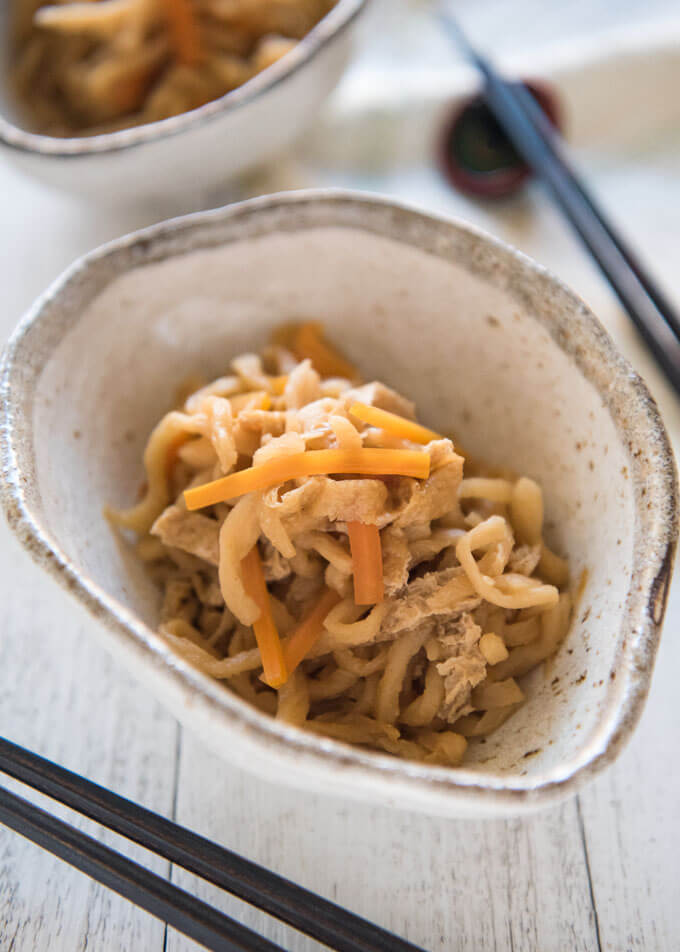
Simmered Kiriboshi Daikon is often served when you want one more dish to complete a meal set in Japan, but it can also be served as a warm salad. It is a perfect dish for a bento box too.
What is Kiriboshi Daikon
Kiriboshi daikon () has been around since the Edo period (1603-1868) and eaten as a preserved food.
Kiriboshi daikon is made by cutting daikon into thick match sticks and drying them under the sun until the moisture is removed. It is cut (), dried () daikon (), hence the name.

Sun-dried daikon is packed with umami and nutrition as the water within the daikon reduces to about 16%. About 95% of daikon is water so you can imagine how the nutrition within daikon is condensed. It is a good source of calcium, fibre, iron and some other nutrients. Dried daikon pieces become 5 times as heavy as their original weight.
If you compare it against the same quantity of fresh daikon, kiriboshi daikon contains 23 times more calcium, 10 times more vitamin B1 & B2, 14 times more potassium, and 16 times more fibre. Only a small amount of dried daikon is included in each serving, but it still comes in ahead of fresh daikon when you compare the nutrition.
You can buy kiriboshi daikon in a pack at Japanese grocery stores. You might also find a Korean version of kiriboshi daikon at Asian grocery stores. It is labelled as dried radish.
How to rehydrate kiriboshi daikon
You need to rehydrate kiriboshi daikon before using them. Prior to rehydrating them, you should rinse the dried daikon pieces in a bowl, changing the water a couple of times.
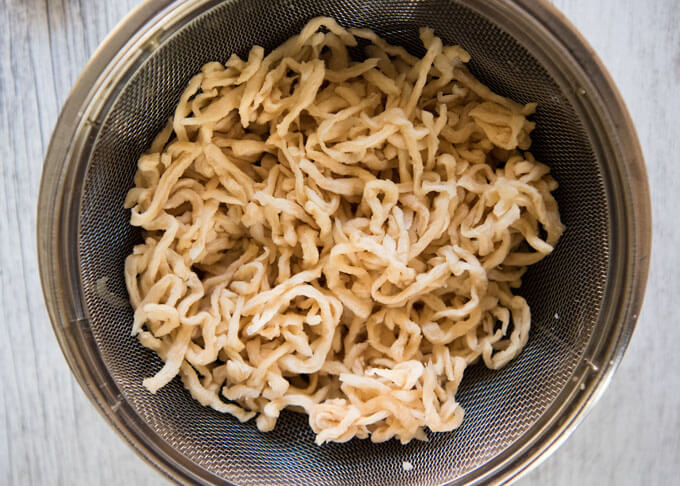
Put the dried daikon pieces in a sufficient amount of water (3 times or more of dried daikon quantity) for 10-20 minutes. The length of time you leave the dried daikon in the water varies depending on how you will cook.
If you are simmering it like todays dish, you only need to rehydrate for 10 minutes as it will be softened further while cooking.
But for a stir-fry or salad (I need to post these dishes one day), you need to leave the dried daikon in the water until it is fully softened (about 15-20 minutes). But do not leave them in the water too long as the good flavour and nutrition will be lost into the water.
Whats in my Simmered Kiriboshi Daikon
There are many variations of Simmered Kiriboshi Daikon but the most commonly used ingredients cooked with kiriboshi daikon are carrot and aburaage (fried thin tofu).
- Carrot cut into thick matchsticks just like rehydrated kiriboshi daikon.
- Aburaage remove excess oil by pouring boiling water over it, then cut it to 5mm wide short strips.
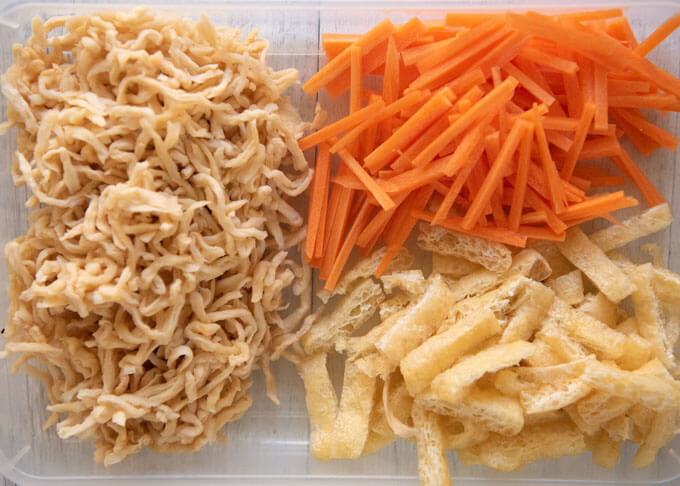
I sometimes add sliced shiitake mushrooms to my kiriboshi daikon. I tend to use fresh shiitake mushrooms rather than rehydrated ones, because I fear that the flavour of the dried mushrooms overpowers the kiriboshi daikon.
To add more colour to the dish, I sometimes use snow peas. I think that adding hijiki seaweed would work well too, but I have not made this yet . See my post Hijiki Seaweed Salad (Hijiki no Nimono) for more details about hijiki and sample photos of dried hijiki.
Simple Simmering Broth
When it comes to simmering broth, I usually use several Japanese seasonings in addition to dashi stock. The most commonly used seasonings are soy sauce, cooking sake, mirin, salt and sugar.
But in the case of Simmered Kiriboshi Daikon, I only add soy sauce and mirin to the dashi stock. I think the kiriboshi daikon itself has great flavour and you dont need to fiddle with the flavour of the broth a lot.
For 400ml/0.8pt of dashi stock, I add 4 tablespoons soy sauce and 2 tablespoon mirin. If you think about it, it is an easy formula to remember, i.e. 4 (hundred ml) + 4 (tbsp) + 2 (tbsp) or 0.8 (pt) +4 (tbsp) + 2 (tbsp).
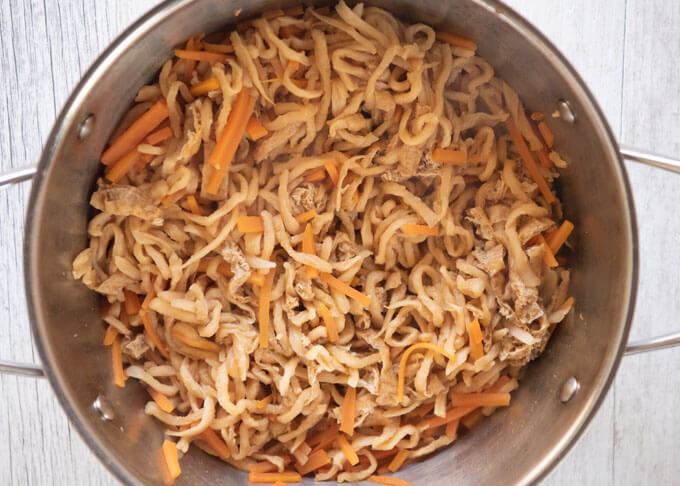
Golden Ratio in cooking
This kind of easy-to-remember ratio is called gonhi () which translates to golden ratio. I know in mathematics the golden ratio means a special number that is applied in geometry, art, architecture and it is believed to make a pleasing/beautiful shape.
But in cooking, an easy-to-remember ratio is the golden ratio. For example, the dipping sauce for Tempura in my recipe has the golden ratio. The portion of dashi stock, mirin and soy sauce is 4:1:1 respectively. This golden ratio is even more perfect as the unit of the portions is all the same!
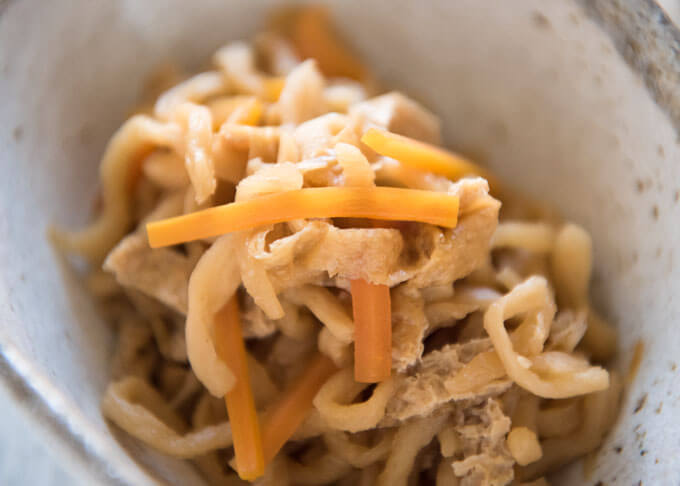
I used the entire bag of kiriboshi daikon today. It weighed 60g/2.1oz and became about 300g/0.7lb when it was rehydrated and the water was squeezed out. The total quantity of Simmered Kiriboshi Daikon can easily serve 4 as a warm salad.
It is a great dish not only as a salad but as an appetiser and a side dish. It is also a great dish to go into a bento box because you can freeze it.
Yumiko![]()
Simmered Kiriboshi Daikon (Dried Shredded Daikon)
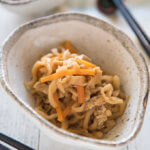
Simmered Kiriboshi Daikon (Shredded Dried Daikon) is a dish of rehydrated dried daikon strips cooked with carrots and aburaage (thin fried tofu) in a lightly flavoured broth. It is a make-ahead dish and one of the very popular side dishes in Japan.
Prep Time includes the time to rehydrate kiroboshi daikon.
Don't forget to see thesection 'MEAL IDEAS' below the recipe card! It gives you a list of dishes that I have already posted and this recipe that canmake up a complete meal. I hope it is of help to you.
- 60g/2.1oz kiriboshi daikon ((note 1))
- 100g/3.5oz carrot ((note 2))
- 2 sheets aburaage
- 2 cups boiling water
- 1 tbsp oil
Simmering Broth
- 400ml/0.8pt dashi stock ((note 3))
- 4 tbsp soy sauce
- 2 tbsp mirin
-
Put kiriboshi daikon in a bowl, fill with water and rinse daikon pieces well, changing water a couple of times.
-
Put the washed daikon pieces into a bowl with about 200ml/6.8oz of water and rehydrate for 10 minutes (it expands to 4-5 times in volume). Squeeze water out.
- Cut carrot into 5cm/2 long, 3mm/ wide match sticks.
- Pour 2 cups of boiling water over aburaage to remove excess oil, then squeeze water out. Cut the aburaage in half lengthwise, then cut into5mm/3/16wide strips crosswise.
-
Heat oil in a saucepan over medium heat. Add carrots and kiriboshi daikon to the suacepan and saut for 1 minute, untangling the daikon strips.
-
Add aburaage strips and stir. Add the Simmering Broth ingredients to the saucepan, mix and bring it to a boil.
-
Reduce the heat to low, place a drop lid on (note 4) and simmer for about 10-12 minutes until only a small amount of liquid remains (note 5).
- Serve in a small bowl as an appetiser or mid-size bowl as a side or a warm salad (note 6).
1. Kiriboshi daikon is dried daikon strips. It is sold at Japanese grocery stores. The net weight of my kiriboshi daikon pack was 60g/2.1oz. Please see more details about kiriboshi daikon in the post.
2. I used carrot but you could also add sliced shiitake mushrooms. Make sure that the total weight is 100g/3.5oz.
3. Some recipes utilise the liquid from the rehydrated kiriboshi daikon and mix with dashi stock. It does add a stronger kiriboshi daikon flavour but it lacks the dashi stock flavour. I prefer it without the liquid from the daikon.
If you use knob dash stock, it becomes a vegetarian dish.
4. A drop lid is called otoshi buta() in Japanese. It is a round lid that is slightly smaller than the opening of a pot. It is traditionally made of wood but I have a stainless lid as well.
It is placed on top of the ingredients in a pot to ensure the food cooks faster, the heat is evenly distributed, and the ingredients stay in place without breaking apart. It also stops the liquid from evaporating quickly.
If you dont have a drop lid, you can make one with aluminium foil or baking paper. Cut a square foil/paper, fold/cut the edges to make it a round shape with the diameter slightly smaller than the pot. Then poke the foil/paper with a knife or a chopstick to make holes in several places.
5. Taste test a strip of daikon and see if you need to cook it a bit longer. If the daikon strips become a semi-transparent light brown, then they are usually ready.
6. If you want to add a colour to the dish, you can use blanched snow peas. I sometimes blanch a few snow peas, diagonally slice them thinly and sprinkle them over the Simmered Kiriboshi Daikon.
7. You can freeze Simmered Kiriboshi Daikon. Cool it and drain the liquid using a sieve before storing it in a zip lock bag. Remove air as much as possible and freeze. It can keep up to 1 month. Microwave to defrost and warm up.
Meal Ideas
A typical Japanese meal consists of a main dish, a couple of side dishes,a soup and rice. I try to come up with a combination of dishes with a variety of flavours, colours, textures andmake-ahead dishes.
When I think of Simmered Kiriboshi Daikon, grilled fish comes to mind automatically. I dont know why but I think that they go perfectly well together. Lightly salted grilled fish is perfect and I decided to serve Grilled Whiting Fillets. But you can serve any grilled fish as the Main.
I now have a salty dish and sweet soy flavour from the Simmered Kiriboshi Daikon. I needed something sour so I picked Lotus Root and Mizuna Salad add some more vegetables to the meal.
- Main: Grilled Whiting Fillets or any other grilled fish.
- Side dish 1: Simmered Kiriboshi Daikon todays recipe, make ahead.
- Side dish 2: Lotus Root and Mizuna Salad you could make ahead.
- Soup:Tofu and Wakame Miso Soup or any other miso soup ingredients of your choice.
- Rice:Cooked Rice
Insert photo
The post Simmered Kiriboshi Daikon (Dried Shredded Daikon) appeared first on RecipeTin Japan.
Did you find this article inspiring? Save THIS PIN to your board and check it later at any time!
